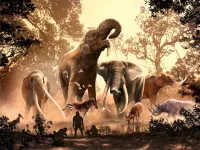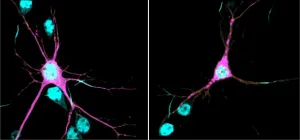The study, published today in Nature Ecology & Evolution, challenges claims that early human hunters slaughtered prehistoric elephants, mammoths and mastodonts to extinction over millennia. Instead, its findings indicate the extinction of the last mammoths and mastodonts at the end of the last Ice Age marked the end of progressive climate-driven global decline among elephants over millions of years.
Although elephants today are restricted to just three endangered species in the African and Asian tropics, these are survivors of a once far more diverse and widespread group of giant herbivores, known as the proboscideans, which also include the now completely extinct mastodonts, stegodonts and deinotheres. Only 700,000 years ago, England was home to three types of elephants: two giant species of mammoths and the equally prodigious straight-tusked elephant.
An international group of palaeontologists from the universities of Alcalá, Bristol, and Helsinki, piloted the most detailed analysis to date on the rise and fall of elephants and their predecessors, which examined how 185 different species adapted, spanning 60 million years of evolution that began in North Africa. To probe into this rich evolutionary history, the team surveyed museum fossil collections across the globe, from London's Natural History Museum to Moscow's Paleontological Institute. By investigating traits such as body size, skull shape and the chewing surface of their teeth, the team discovered that all proboscideans fell within one of eight sets of adaptive strategies.
"Remarkably for 30 million years, the entire first half of proboscidean evolution, only two of the eight groups evolved," said Dr Zhang Hanwen, study coauthor and Honorary Research Associate at the University of Bristol's School of Earth Sciences.
"Most proboscideans over this time were nondescript herbivores ranging from the size of a pug to that of a boar. A few species got as big as a hippo, yet these lineages were evolutionary dead-ends. They all bore little resemblance to elephants."
The course of proboscidean evolution changed dramatically some 20 million years ago, as the Afro-Arabian plate collided into the Eurasian continent. Arabia provided crucial migration corridor for the diversifying mastodont-grade species to explore new habitats in Eurasia, and then into North America via the Bering Land Bridge.
"The immediate impact of proboscidean dispersals beyond Africa was quantified for the very first time in our study," said lead author Dr Juan Cantalapiedra, Senior Research Fellow at the University of Alcalá in Spain.
"Those archaic North African species were slow-evolving with little diversification, yet we calculated that once out of Africa proboscideans evolved 25 times faster, giving rise to a myriad of disparate forms, whose specialisations permitted niche partition between several proboscidean species in the same habitats. One case in point being the massive, flattened lower tusks of the 'shovel-tuskers'. Such coexistence of giant herbivores was unlike anything in today's ecosystems."
Dr Zhang added: "The aim of the game in this boom period of proboscidean evolution was 'adapt or die'. Habitat perturbations were relentless, pertained to the ever-changing global climate, continuously promoting new adaptive solutions while proboscideans that didn't keep up were literally, left for dead. The once greatly diverse and widespread mastodonts were eventually reduced to less than a handful of species in the Americas, including the familiar Ice Age American mastodon."
By 3 million years ago the elephants and stegodonts of Africa and eastern Asia seemingly emerged victorious in this unremitting evolutionary ratchet. However, environmental disruption connected to the coming Ice Ages hit them hard, with surviving species forced to adapt to the new, more austere habitats. The most extreme example was the woolly mammoth, with thick, shaggy hair and big tusks for retrieving vegetation covered under thick snow.
The team's analyses identified final proboscidean extinction peaks starting at around 2.4 million years ago, 160,000 and 75,000 years ago for Africa, Eurasia and the Americas, respectively.
"It is important to note that these ages do not demarcate the precise timing of extinctions, but rather indicate the points in time at which proboscideans on the respective continents became subject to higher extinction risk," said Dr Cantalapiedra.
Unexpectedly, the results do not correlate with the expansion of early humans and their enhanced capabilities to hunt down megaherbivores.
"We didn't foresee this result. It appears as if the broad global pattern of proboscidean extinctions in recent geological history could be reproduced without accounting for impacts of early human diasporas. Conservatively, our data refutes some recent claims regarding the role of archaic humans in wiping out prehistoric elephants, ever since big game hunting became a crucial part of our ancestors' subsistence strategy around 1.5 million years ago," said Dr Zhang.
"Although this isn't to say we conclusively disproved any human involvement. In our scenario, modern humans settled on each landmass after proboscidean extinction risk had already escalated. An ingenious, highly adaptable social predator like our species could be the perfect black swan occurrence to deliver the coup de grâce."
INFORMATION:
Paper
'The rise and fall of proboscidean ecological diversity' by Cantalapiedra, J.L. et al. in Nature Ecology & Evolution.
Notes to editors
Dr Zhang Hanwen (Steven) is available for interview. To schedule this please email hz1646@bristol.ac.uk and Victoria Tagg, Media & PR Manager (Research) at the University of Bristol: victoria.tagg@bristol.ac.uk
Image 1
https://www.dropbox.com/s/5x8la93rydm40bu/Proboscideans_05_202106281839.jpg?dl=0
Caption: Dusk falls on East Africa's Turkana Basin 4 million years ago, where our early upright-walking ape ancestors, Australopithecus anamensis (foreground), shared their habitat with several coexisting proboscidean species, as part of a spectacular herbivore community containing some progenitors of today's charismatic East African animals. Background (left to right): Anancus ultimus, last of the African mastodonts; Deinotherium bozasi, colossal herbivore as tall as a giraffe; Loxodonta adaurora, gigantic extinct cousin of modern African elephants, alongside the closely-related, smaller L. exoptata. Middle ground (left to right): Eurygnathohippus turkanense, zebra-sized three-hoofed horse; Tragelaphus kyaloae, a forerunner of the nyala and kudu antelopes; Diceros praecox - ancestor of the modern black rhino.
Image Credit: Julius Csotonyi
Image 2
https://fluff.bris.ac.uk/fluff/u4/oc20541/v_59HHlbNlmGlcksDqQSWg1Yx/
Caption: Highly complete fossil skull of a typical mid Miocene 'shovel-tusker', Platybelodon grangeri, roamed in large herds across Central Asia 13 million years ago. The specimen is display mounted at the Hezheng Paleozoological Museum, Gansu Province, China.
Image Credit: Zhang Hanwen
Image 3
Prehistoric Safari : Pliocene Southern Europe by Jagroar on DeviantArt
Caption: A scene from northern Italy 2 million years ago - the primitive southern mammoths Mammuthus meridionalis (right-hand side) sharing their watering hole with the mastodont-grade Anancus arvernensis (left-hand side), the last of its kind. Other animals that brought an 'East African air' to Tuscany included rhinos, hippos and zebra-like wild horses.
Image Credit: Tamura Shuhei
Image 4
https://fluff.bris.ac.uk/fluff/u1/oc20541/4PMeZt3JACnJAleUjt22cw1YD/
Caption: The gallery of extinct proboscideans in the Muséum national d'Histoire naturelle, Paris, echoing their bygone golden age.
Image Credit: Zhang Hanwen
Image 5
https://fluff.bris.ac.uk/fluff/u1/oc20541/E_fIvR_egAsinlpv36_srg1YR/
Caption: Disparity of proboscidean forms through 60 million years of evolution. Early proboscideans like Moeritherium (far left) were nondescript herbivores typically the size of a pig. But subsequent evolution of this lineage was almost consistently dominated by gigantic species, many considerably larger than today's elephants (e.g. Deinotherium 2nd left; Palaeoloxodon furthest right). A key factor of proboscidean evolutionary innovation lies with disparities in tooth morphology.
Image credit: Óscar Sanisidro


